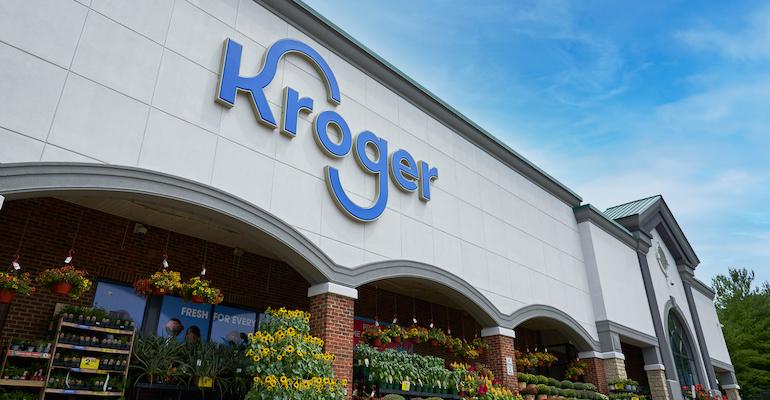It’s all coming together for The Kroger Co.
Back in May 2018, Kroger unveiled an exclusive U.S. partnership with U.K.-based online grocery specialist Ocado Group. The aggressive plan called for the companies to identify sites for about 20 automated customer fulfillment centers (CFCs) in the United States over the next three years. These high-tech Kroger CFCs would use Ocado’s vertical integration, machine learning and robotics to fill e-grocery delivery orders, providing the supermarket giant with the capacity, speed and efficiency to serve a market base stretching across more than 2,700 stores in 35 states and the District of Columbia plus vast online properties.
Many industry analysts called the Ocado alliance a big win for Kroger. Not only would it would turn up the competitive heat on rivals and blaze a path to profitability in online grocery, but it also would give Kroger potentially national scale in grocery e-commerce — including states and markets where it doesn’t operate brick-and-mortar stores.
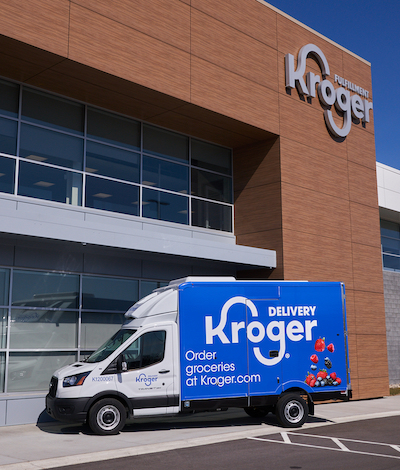 Kroger opened its first Ocado customer fulfillment center (CFC), a 375,000-square-foot automated warehouse, or “shed,” in April 2021 in Monroe, Ohio. (Photo courtesy of Kroger)
Kroger opened its first Ocado customer fulfillment center (CFC), a 375,000-square-foot automated warehouse, or “shed,” in April 2021 in Monroe, Ohio. (Photo courtesy of Kroger)
However, other analysts saw the Ocado deal as a risky bet for Kroger. They described the CFC model as capital- and labor-intensive and said the big centers — scaling to well over 300,000 square feet — would take too long to open, be situated too far from customers (adding costs for transportation and supporting facilities) and possibly cannibalize sales from stores. Such large-scale operations, they noted, also would require dense markets to achieve ROI and profitability, at a time when online penetration in the U.S. grocery market stood at low single digits.
Fast forward to August 2022. Kroger has announced 17 CFCs overall — ranging from 135,000 to 375,000 square feet — and six are now open. To support the regional CFCs and enlarge their service area, the Cincinnati-based company also has announced 12 Ocado-automated “spoke” facilities of 40,000 to 80,000 square feet, with seven now live. One operational CFC and three spokes have brought Kroger into one new state, and upcoming facilities stand to extend its geographic reach into two more states and one new region.
Meanwhile, the COVID-19 pandemic has hoisted online grocery sales. The market rose from 2.7% and 3.4% of total U.S. grocery sales in 2018 and 2019 to 8.1% and 9.5% in 2020 and 2021, according to the Mercatus/Incisiv “eGrocery Transformed” report. That percentage is expected to hit 11.1% in 2022 and 13.5% in 2023, climbing to 20.5% by 2026.
The U.S. also now has a lot more online grocery shoppers. In 2019, 33.8% of the population were digital grocery buyers, eMarketer reported. But since the onset of COVID, that share jumped to 47.8% in 2020, 49.7% in 2021 and 51.3% in 2022, with a forecast to reach 52.4% in 2023 and 53.3% in 2024.
Against that backdrop, Kroger stands strongly positioned as a leader in fresh foods, own brands, consumer data and analytics, and omnichannel shopping — the company’s “competitive moats” of “Fresh, Our Brands, Personalization and Seamless.”
For its vision and embrace of innovation in executing its “Leading with Fresh and Accelerating with Digital” strategy, The Kroger Co. has been named as the 2022 Retailer of the Year by Supermarket News.
“In every decision we make, we do what we think is right for customers and right for our associates as we look 10 years into the future,” Kroger Chairman and CEO Rodney McMullen told SN in an interview.
“From everything that we could see, the customer really wants and needs a retailer that’s able to serve them with physical stores, pickup and delivery. And what we find is that customers bounce back and forth between those channels, depending on what’s going on in their household. When you look at the long-term trend, we fundamentally believed that would become increasingly important,” McMullen said. “And then you look at, how do you do that efficiently? We’ve always told our investors, job one is to make sure we take care of the customer, but as they move to online, that customer is not as profitable. So job two is to figure out how to serve that customer profitably. When you look at the overall ecosystem, that’s really what led us to Ocado.”
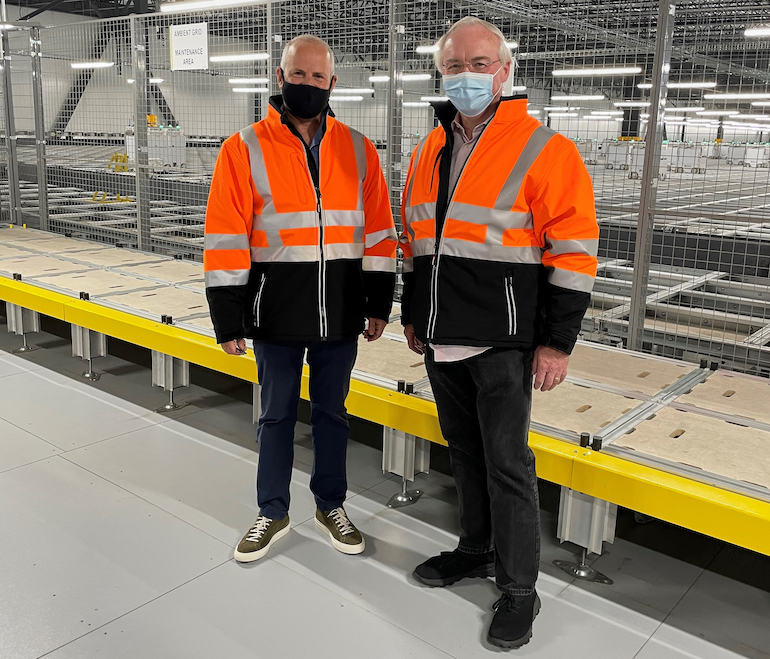
Kroger Chairman and CEO Rodney McMullen (right) with Ocado CEO Tim Steiner at Kroger's CFC in Groveland, Fla.
Ocado network takes shape
Kroger opened its first Ocado CFC, a 375,000-square-foot automated warehouse, or “shed,” in April 2021 in Monroe, Ohio. That was followed by 375,000-square-foot CFCs in Groveland, Fla., in June 2021 and in Forest Park, Ga., this past February and a 340,000-square-foot CFC in Pleasant Prairie, Wis., in June. Most recently, CFCs of 135,000 and 350,000 square feet went operational in Romulus, Mich., and Dallas, respectively.
The Ocado CFCs use automation and artificial intelligence to service online grocery orders, with on-site associates supporting delivery operations and helping to process, package and load orders.
In the Monroe CFC, for example, more than 1,000 bots containing totes with products and ready customer orders dart across huge 3D grids — known as “The Hive” — managed by air-traffic control systems. When order delivery times near, the bots retrieve the products from The Hive and bring them to pick stations, where items are sorted for delivery. Algorithms control the pick-and-sort process to ensure that products are packed intelligently, with fragile items on top and bags evenly weighted. Next, packed orders are loaded into a temperature-controlled Kroger Delivery van that can hold up to 20 orders. Machine-learning algorithms weigh factors such as road conditions and fuel efficiency to optimize delivery routes.
Shoppers place their orders via Kroger.com or the Kroger mobile app. Each Ocado CFC covers a delivery radius of up to 90 miles. Depending on its size, a CFC can equal the sales of about 20 stores, according to Kroger. At full capacity, annual sales per module — the Monroe CFC has seven modules — are projected at $80 million to $100 million.
So far, Kroger has six Ocado-automated CFCs and nine supporting spoke facilities operational.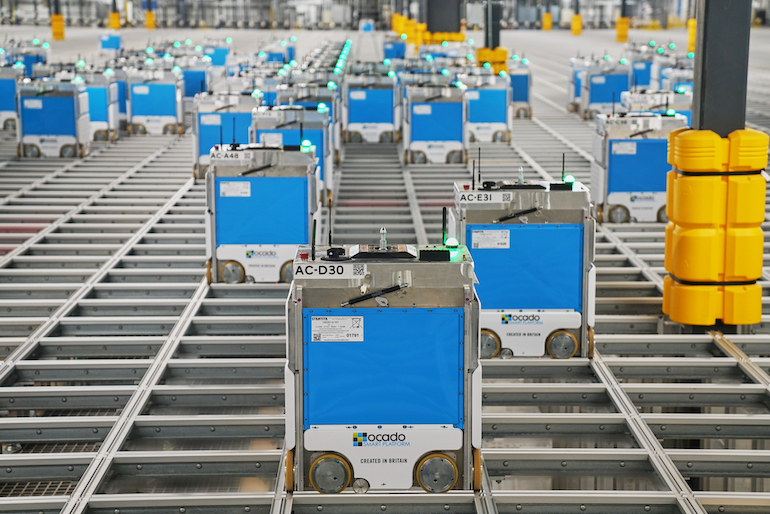
“Ocado is incredibly efficient. The thing that I’ve always been impressed with, since signing our original agreement with Ocado, is not so much what they were then but what they will become,” McMullen explained. “We had studied Ocado on and off over the years, and the thing that always impressed us was that they just kept getting better and better. And they continue to aggressively invest in R&D. That R&D is focused on two things: how to improve the customer experience and how to improve the efficiency of the operation. Since we’ve developed a deeper partnership with them, they’ve really improved the consistency and the experience for the customer. That’s why we identified Ocado, why we partnered with them and why we’re pleased with the continued progress that we’re making.”
Upcoming Ocado CFCs, Kroger reported, include locations in Frederick, Md.; Phoenix; Charlotte, N.C.; Aurora, Colo.; the Cleveland region; the Pacific Northwest; and the Northeast. The retailer, too, has announced plans for two CFCs in Southern California and two more in Florida.
The Kroger Delivery network also includes Ocado-powered spoke facilities that serve as last-mile, cross-dock sites to help the CFC “hubs” process online grocery and fresh food orders and extend their service radius, up to 200 miles. Spokes are now live in Miami, Tampa and Jacksonville, Fla.; Lockbourne, Ohio; Indianapolis; Louisville, Ky.; and San Antonio. Other spokes are slated to open in Oklahoma City; Austin, Texas;Birmingham, Ala.; Nashville, Tenn.; and Maywood, Ill.
“It’s one of those things where you continue to learn, and each one gets a little bit easier to operate than the first one,” said McMullen. “The thing that I focus on every single week is our Net Promoter Scores from the customer, our repeat purchase rate and how customers engage with us, both in physical stores and pickup and delivery. In all those things, we will continue to make progress. I’m really proud of all the hard work everyone has done and really pleased with where we are.”
Reaching into new markets
The opening of the Groveland CFC and its three supporting spokes enabled Kroger, for all practical purposes, to enter a new state: Florida. Previously, the company only had a Harris Teeter supermarket in the Jacksonville area.
Delivery to South Florida launched in June, following the inception of service to the greater Orlando, Tampa and Jacksonville areas. Last October, Kroger said it plans to build two small CFCs in South Florida that will join its live e-grocery operations in Central Florida. The new sites are slated to include a “Zoom” micro-fulfillment center that will enable Kroger Delivery in as soon as 30 minutes from a selection of 10,000 fresh food items and essentials, plus a larger facility offering same-day and next-day service from an assortment of 35,000 items, according to Kroger.
The Ocado CFCs serve a delivery radius of about 90 miles, extended to up to 200 miles by spoke fulfillment sites.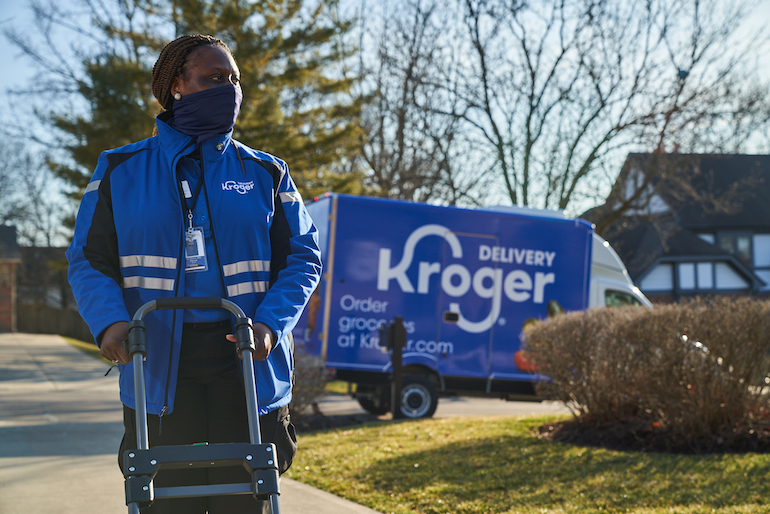
“It’s fascinating. In Florida, over half of the customers knew that Kroger sold groceries. Now the thing we have to help customers in Florida understand is they can buy them from us not just at a physical store,” McMullen noted. “The other thing that the [Ocado] sheds will allow us to do is test different things. In Dallas, we’re actually testing serving restaurants in that market, right through our shed [CFC]. And then there’s leveraging Our Brands. One of the things I’ve really been pleased with is the fact that Our Brands’ share of market in Florida is actually a little bit better than in our historical core markets. That just shows the strength and the quality of Our Brands.”
The 50,000-square-foot spoke in Oklahoma City, due to go into operation later this year, will support the Dallas CFC and bring Kroger into Oklahoma, its 36th state. Likewise, the Cleveland region CFC will serve areas in northeastern Ohio and Pennsylvania, with the latter representing the grocer’s 37th state. In October 2021, Kroger announced plans to build a CFC in the Northeast — where it has no physical stores — but has yet to provide details about the facility and its opening time frame.
“Long term, one of our visions is to serve America, because we think everybody deserves fresh, affordable food,” said McMullen. “It allows us to go into new markets with something different than what is already there and do it in a way that’s efficient. And you can scale off of it over time. So that’s one more way of taking care of customers and supporting communities.”
Cultivating a seamless ecosystem
The Ocado network will underpin the e-commerce portion of what Kroger envisions as a “seamless” ecosystem, with customers able to easily move between channels — brick-and-mortar stores and digital, and among in-store shopping, pickup and delivery — and get the same high-quality experience.
Currently, The Kroger Co. operates 2,723 supermarkets and multi-department stores under more than 20 banners, including Kroger, Ralphs, Dillons, Smith’s, King Soopers, Fry’s, QFC, City Market, Owen’s, Jay C, Pay Less, Baker’s, Gerbes, Harris Teeter, Pick N’ Save, Metro Market, Mariano’s, Fred Meyer, Food 4 Less and Foods Co. More than 2,250 stores have pharmacies, and over 1,600 have fuel centers. Eighty-two percent of Kroger’s customers within five miles of one of its stores, with most living within two miles.
On the digital side, as of the fiscal 2021 year-end, 2,257 stores provided online grocery pickup, and over 2,500 stores offered delivery. Including click-and-collect and delivery via Kroger Delivery, third-party partners such as Instacart and Kroger’s Ship direct-to-home service, the company covered 98% of households in its trade area with e-commerce services.
Kroger serves over 60 million households annually through its stores and digital properties.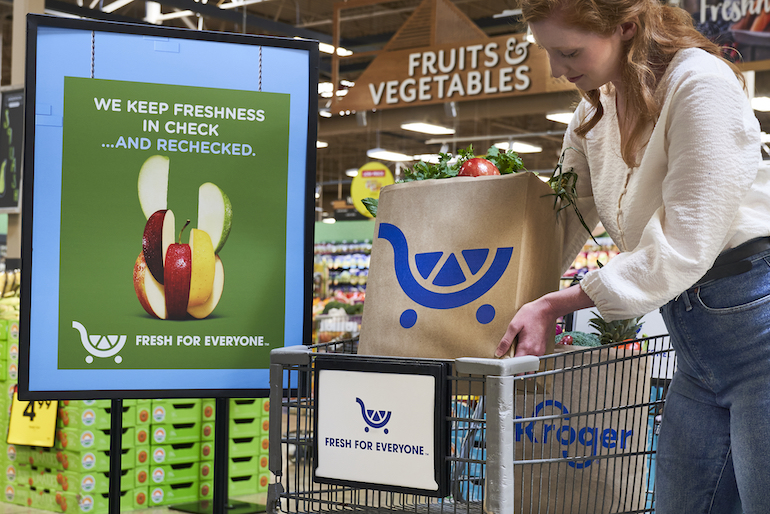
“When customers engage with us, we think it’s really important. We call it ‘zero compromise.’ Customers should never have to compromise an experience, and that’s everything from how easy is it, fair and reasonable prices, using our data to personalize the experience and making sure the product is incredibly fresh,” explained McMullen. “When you look at our [Ocado] sheds, that’s part of the seamless system, and it facilitates that overall connection with the customer in all those dimensions. It also makes it incredibly easy to be consistent with the experience for the customer. One of the things I think is important relative to some of our competitors is that the consistency of our seamless [digital] experiences are the same consistency that you would have when you go into the stores every day.”
Digital represents a more than $10 billion annual business for Kroger. About 18.5 million households engaged online with the retailer in 2021, and in the fiscal 2022 first quarter digitally engaged households grew by another half-million. Kroger also made further enhancements to its seamless experience.
“Our seamless ecosystem continues to deliver fresh products to our customers, anytime, anywhere, and with zero compromise,” McMullen told analysts in a conference call on Q1 results. “During the first quarter, more customers returned to in-store shopping and, as a result, we made strides to enhance that experience while introducing new tools that help our associates better serve customers. In pickup, we unveiled new technology that improved wait times 20% and expanded capacity based on customer needs. In delivery, we continue to introduce key initiatives that expand our reach and shorten delivery times. We strive to provide more customers access to high-quality affordable food, regardless of whether they have a physical store in their community.”
In March, during a 2022 business update event with investors, Kroger reiterated its goal from 2021 to double its digital sales and passthrough profitability rate by the end of 2023, driven by its seamless experience and ecosystem.
“We’re continuing to make progress,” McMullen told SN. “COVID accelerated the growth of seamless and digital business by three or four years, and that stayed with us. On the end of the last earnings call [Q1], I mentioned that our seamless business had turned positive in terms of sales growth. It’s also important to note that almost all of the customers that used to shop digital and got comfortable coming back to stores are coming back to stores at Kroger. So it just shows you the ability for people to move back and forth. And we have continued to see household growth in terms of people engaging with us digitally.”
Kroger's vision is for customers to easily move between channels — brick-and-mortar stores and digital, and among in-store shopping, pickup and delivery — and get the same high-quality experience.
In July, Kroger rolled out its eight-month-old Boost by Kroger online benefits program nationwide. Boost comes two membership tiers, at $59 or $99 annually. All members get free delivery for online orders of $35 or more and double fuel points (up to $1 off per gallon of gasoline) for each dollar spent on groceries and general merchandise. The $59 annual membership provides delivery within 24 hours, while the $99-per-year option offers delivery in as soon as two hours. Those signing up for either Boost membership tier get a one-time welcome kit valued at over $100. Kroger said the kit offsets the first-year cost of membership and estimated that Boost can save customers more than $1,000 per year on fuel and grocery delivery.
The subscription program initially was piloted in Kroger’s Cincinnati-Dayton, Columbus, Atlanta and Central divisions. “Delivery [sales] increased significantly compared to non-Boost divisions, and delivery retention improved approximately 600 basis points,” McMullen said in the Q1 analyst call.
Leading with fresh, serving up Our Brands
Fresh foods also are major catalyst for customer engagement across Kroger’s seamless ecosystem. In Kroger’s March business update, Stuart Aitken, chief merchant and marketing officer, noted that fresh is the No. 1 determinant of store choice, as 70% of customers base their choice of shopping venue on fresh products, and 92% of Kroger’s shoppers buy fresh products.
Since 2019, the retailer has seen 15.6% sales growth in fresh departments, and in Q1 2022, identical sales grew 5.2% in fresh. Helping to drive that gain was the acceleration of Kroger’s End-to-End Fresh Produce initiative.
Kroger said it's winning customers and market share with strong offerings in its fresh food departments.
“When you look at fresh, the majority of our customers decide where to shop based on the fresh experience, and it’s something that Kroger has always started with and had a strength versus competitors,” McMullen said in the interview. “And it’s an opportunity for us to even get better because there are plenty of opportunities to improve. At the end of the last quarter, we announced that we had 355 new stores certified on End-to-End Fresh Produce. Our expectation is that, over time, you’ll hear us continuing to add share as that accelerates.
“The other thing is we’re in a unique position when you think about food as medicine,” he added. “We have the ability — given our produce departments, physical stores and expertise in health and wellness — to really merge those two. And we’re starting to work with outside partners to better understand that.”
Through the End-to-End program, Kroger leverages data, science and partner collaboration to fine-tune produce distribution, cut the time from farm to table and ensure supply-chain stakeholders are working together to reduce the age of the product, minimize dwell time in the distribution network and maintain the cold chain. In stores, the retailer is bolstering vendor accountability by updating technology that provides real-time data to suppliers to deliver more days of freshness.
“The produce departments in our initial rollout are performing better than similar stores that haven’t implemented the in-store portion of our end-to-end process, and we have plans for continued rollout in 2022,” Aitken reported in the update event. “And produce is just the beginning of our end-to-end initiative. We see similar opportunities across the store in meat and seafood and, of course, in dairy.”
Kroger’s Our Brands private-label lineup is another big draw for customers. An approximately $28 billion annual business, which would make Kroger the ninth-largest U.S. CPG company, the portfolio encompasses nearly 20 brands and offers 14,000 items. Four labels are billion-dollar brands, including Simple Truth, Private Selection, Home Chef and Kroger — the latter being the largest by far with sales of $15 billion and Simple Truth the nation’s largest natural/organic brand. Meal kit brand Home Chef joined the billion-dollar club in 2021.
More than 660 new Our Brands items were added in fiscal 2021, followed by another 239 in the 2022 first quarter. Identical sales of Our Brands in Q1 rose 6.3%, eclipsing growth for national brands, according to Kroger.
“If you look at last quarter, the growth of Our Brands outpaced the overall growth of the company,” McMullen said. “The Our Brands team is made up of Kroger people and external people from the CPG world who are very knowledgeable of innovation in brand products. It’s really the best of all those together. And every year, we’re introducing new products. Last year, I think we introduced [over 600], and I know this year we’re on pace to exceed that. Part of that is, how do you keep it fresh? How do you keep it interesting for the customer? And you know, they don’t have to compromise because of the great value for the money and incredible quality.”
As Kroger builds its omnichannel network, the reach of its Our Brands private-label portfolio could extend to markets where the grocer lacks physical stores.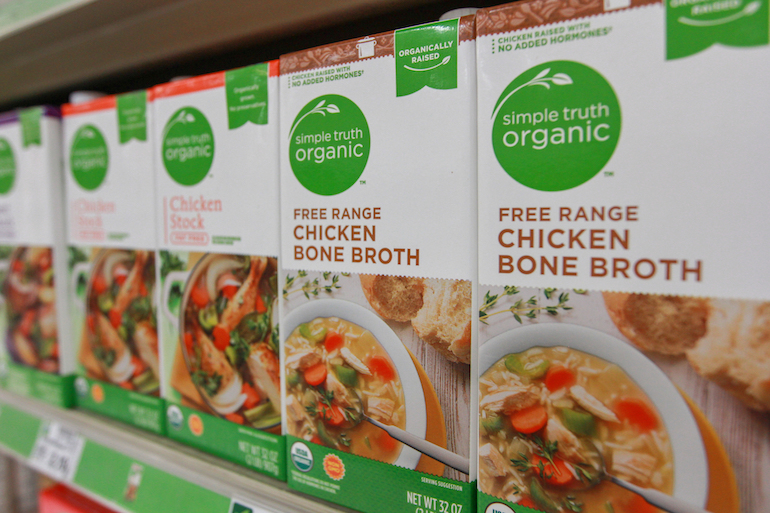
Catering to the customer
Kroger noted that its more than 20 years of investment in data science has enabled the company to leverage the information across its physical and virtual properties and brands to create personalized experiences and value for our customers. Overall, Kroger serves more than 60 million households annually, and 96% of customer transactions are tied to Kroger loyalty program.
“Data is only important when you use it in a way that’s helpful for the customer. What we try to do is to make sure that every customer has a unique experience with us, and that’s what’s important to them and their household. So we’ll use our data, right now obviously with inflation, to try to help people stretch their budget. We also make sure we thank customers for shopping with us. So we offer them something we know is important to them or their household,” said McMullen. “You may notice, every year, we announce what we see as food trends. Well, those food trends are coming out of what we’re seeing with our data. And it’s how we also allocate resources in introducing new products, for Our Brands as well.”
Chief Information Officer Yael Cosset said at the business update event that Kroger’s expanded loyalty and personalization platform enables the retailer to “provide value that matters to each customer,” with more than 2trillion relevant recommendations and 50% of items added to the basket due to personalized search. Omnichannel customers are the most exposed to personalization, he said, and exhibit 98% retention and spend two to four times what an average customer spends.
Data and technology are “key to our mission to elevate the customer experience and grow sales,” according to Mary Ellen Adcock, senior vice president of operations for Kroger. During the update event, she said that in 2021 Kroger introduced a new fresh production, automated forecasting and ordering application using artificial intelligence. Real-time analytics also are available to coach associates to help them make better and faster decisions, based on customer data and operational data.
“What’s so exciting about technology is that you continue to figure out how to make things even better,” McMullen said in the interview. “That’s the thing that’s so important. Tomorrow, we’ll give customers a better experience than they had yesterday. We always will focus on making sure that every single day we serve the customer a little bit better.”

